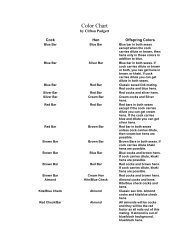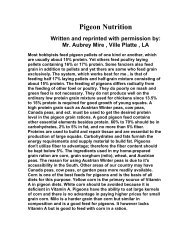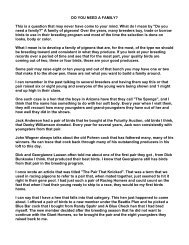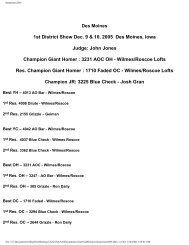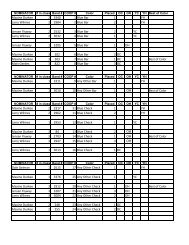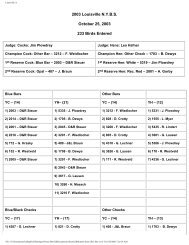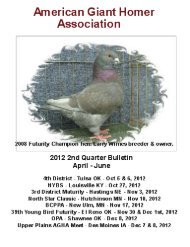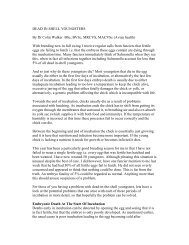Creation of the Giant Homer - American Giant Homer Association
Creation of the Giant Homer - American Giant Homer Association
Creation of the Giant Homer - American Giant Homer Association
Create successful ePaper yourself
Turn your PDF publications into a flip-book with our unique Google optimized e-Paper software.
<strong>Creation</strong>OfThe <strong>American</strong> <strong>Giant</strong> <strong>Homer</strong>And <strong>the</strong> Rise <strong>of</strong>The <strong>American</strong> <strong>Giant</strong> <strong>Homer</strong> <strong>Association</strong>1918 – 1928By Marion L. GrahamThe year 1918 marks <strong>the</strong> actual documented beginning <strong>of</strong> <strong>the</strong> Bird --- eventually named <strong>the</strong> <strong>American</strong><strong>Giant</strong> <strong>Homer</strong>.The “<strong>American</strong>” <strong>Giant</strong> <strong>Homer</strong> <strong>Association</strong> was organized in <strong>the</strong> year 1928; however, <strong>the</strong> historical“roots” go back a lot <strong>of</strong> years before that. In <strong>the</strong> beginning <strong>of</strong> <strong>the</strong> <strong>Giant</strong> <strong>Homer</strong> <strong>Association</strong>, <strong>the</strong> word“<strong>American</strong>” was not a part <strong>of</strong> <strong>the</strong> organizational name. Some years later, when <strong>the</strong> <strong>Association</strong> membersrealized that <strong>the</strong>y had created something truly <strong>American</strong> in every respect, did <strong>the</strong> word “<strong>American</strong>”appear as part <strong>of</strong> <strong>the</strong> <strong>Association</strong>’s name.Some years after 1928, Stanley Stout, one <strong>of</strong> <strong>the</strong> earliest <strong>Giant</strong> <strong>Homer</strong> <strong>Association</strong> Pioneers, wrote toPaul Steiden thanking him for sending in his <strong>Giant</strong> <strong>Homer</strong> <strong>Association</strong> dues ($1.00). Paul Steiden hadasked Stanley Stout some questions about <strong>the</strong> crossing <strong>of</strong> breeds to produce “<strong>Giant</strong>” homers. Stout wroteback to Paul and informed him that <strong>the</strong> “colored <strong>Giant</strong> <strong>Homer</strong>s (that existed at that time) were bredfrom flying <strong>Homer</strong>s only, and <strong>the</strong> large breast area <strong>of</strong> <strong>the</strong> bird was built by selectively mating bigger andbigger birds toge<strong>the</strong>r.” Stout stated that as far as her knew, “<strong>the</strong>re was no o<strong>the</strong>r blood in <strong>the</strong> ‘first’ <strong>Giant</strong><strong>Homer</strong>s but big, flying, Racing <strong>Homer</strong>s.”Utilizing <strong>the</strong> above mentioned breeding concept (generally), <strong>the</strong> first strains <strong>of</strong> <strong>Giant</strong> <strong>Homer</strong>s werebegun by two earlier <strong>Giant</strong> <strong>Homer</strong> <strong>Association</strong> pioneers, R.W. Keene and Wm. P. Gray in <strong>the</strong> year 1918.This “documented date” was only <strong>the</strong> continuation <strong>of</strong> <strong>the</strong>ir breeding work which had really started someyears before 1918 --- and continued for many years following. The two <strong>of</strong> <strong>the</strong>m worked toge<strong>the</strong>r as“co-pioneers” in <strong>the</strong> creation <strong>of</strong> <strong>the</strong> “<strong>American</strong>” <strong>Giant</strong> <strong>Homer</strong> --- but each on a somewhat differentproject. Gray worked to produce a strain <strong>of</strong> “pure white <strong>Giant</strong> <strong>Homer</strong>s. They were bred ‘straight’ frombig, white, flying, Racing <strong>Homer</strong>s.” Stout fur<strong>the</strong>r Stated that “<strong>the</strong> ‘colored’ <strong>Giant</strong>s that Keene producedwere from Racers and English Show <strong>Homer</strong>s ---crossed.” Keene continued to breed his birds carefully for<strong>the</strong> first twelve years to get <strong>the</strong>m pure white and eliminate <strong>the</strong> “recognizable” evidence <strong>of</strong> <strong>the</strong> Show<strong>Homer</strong> out <strong>of</strong> <strong>the</strong>m. Only <strong>the</strong>n did Keene consider his birds a new “strain” <strong>of</strong> <strong>Giant</strong> <strong>Homer</strong>s without toomuch conscience about <strong>the</strong>ir being cross-breeds. They became known widely (at that time) as “<strong>the</strong> beststrain <strong>of</strong> <strong>Giant</strong> <strong>Homer</strong>s in <strong>the</strong> world.”The average weight <strong>of</strong> Gray and Keene’s <strong>Giant</strong> <strong>Homer</strong>s was about twenty ounces (and increasing)somewhat lighter than some <strong>of</strong> <strong>the</strong> o<strong>the</strong>rs that were generally considered BIG breeds.So --- if Keene and Gray started (openly) on <strong>the</strong>ir <strong>Giant</strong> <strong>Homer</strong> projects in (about) 1918 --- and <strong>the</strong>ycontinued working on <strong>the</strong>ir individual breading projects for “at least” twelve years --- this would bring<strong>the</strong> “new” <strong>Giant</strong> <strong>Homer</strong> to recognizable status somewhere around <strong>the</strong> year 1928, <strong>the</strong> year that <strong>the</strong>“<strong>American</strong>” <strong>Giant</strong> <strong>Homer</strong> <strong>Association</strong> was organized.
The pioneers in <strong>the</strong> creation <strong>of</strong> <strong>the</strong> <strong>Giant</strong> <strong>Homer</strong> also became pioneers in <strong>the</strong> establishment <strong>of</strong> <strong>the</strong> <strong>Giant</strong><strong>Homer</strong> <strong>Association</strong>. R.W. Keene was <strong>the</strong> first Charter President, C.F. Hober became Vice President, andWm. P. Gray became Secretary-Treasurer.Between 1918 and 1928 many pigeon breeders were trying to develop bigger and better <strong>Homer</strong>s --- asduring those early years <strong>the</strong> squab was a most popular table delicacy and pr<strong>of</strong>itable economic product.The early Squabbing <strong>Homer</strong> was not always known as <strong>the</strong> “<strong>Giant</strong> <strong>Homer</strong>”. In 1919 and 1920, <strong>the</strong> WilsonPigeon Farm, in Wilson, Kansas, called <strong>the</strong>ir best squabbers, <strong>the</strong> <strong>Homer</strong>, just a “Squab-breedingpigeon.” In 1921, <strong>the</strong> Quality Pigeon L<strong>of</strong>ts, in Marinette, Wisconsin, called <strong>the</strong> Squabbing <strong>Homer</strong> <strong>the</strong>“Classy Flying Utility Bird.” Also in 1921, <strong>the</strong> Marksacre Pigeon L<strong>of</strong>ts were selling <strong>Homer</strong>s as “SquabBreeders” and “Exhibition Birds.” W.C. Osterwisch, in New Memphis, Illinois, was selling “SquabBreeding <strong>Homer</strong>s.” At <strong>the</strong> same time, in Butler, Pennsylvania, <strong>the</strong> Ideal Squab Company Inc. wasstarting to produce a larger squabbling <strong>Homer</strong> cross. So here in 1021 we can mark <strong>the</strong> beginning <strong>of</strong> acompletely new movement in developing larger utility squab breeders ---Cross-Breeding.Beginning slowly after 1918 --- picking up momentum in 1921 --- many squab producers were raisingflying, working Racing <strong>Homer</strong>s along with one or more breeds <strong>of</strong> <strong>the</strong> “BIG SIX” utility group --- tryingto combine <strong>the</strong> prolific production ability <strong>of</strong> <strong>the</strong> Working <strong>Homer</strong> with <strong>the</strong> larger size <strong>of</strong> <strong>the</strong> “BIG SIX”utility breeds. The “BIG SIX” utility group consisted <strong>of</strong> Hungarians, Runts, Maltese, Carneaux, WhiteKings, and Registered White Swiss Mondaines. The <strong>Homer</strong> breeders were seriously beginning to use<strong>the</strong>se “BIG SIX” breeds solely as tools to make <strong>the</strong>ir <strong>Giant</strong> <strong>Homer</strong>s bigger and more prolific producers <strong>of</strong>heavier squabs.It is general scientific knowledge that “Hybridization” <strong>of</strong> compatible breeds <strong>of</strong> plants and animalsincreases <strong>the</strong> capacity for improved production. In 1920, <strong>the</strong> Cedar Lawn Poultry Farm, in Morristown,New Jersey, were raising White Swiss Mondaines, Carneaux, and Working <strong>Homer</strong>s toge<strong>the</strong>r --- crossbreeding.H.N. Webb, <strong>of</strong> Springfield, Missouri, was also crossing <strong>Homer</strong>s with Carneaux andMondaines. L.N. Simons, <strong>of</strong> Philadelphia, Pennsylvania, was crossing Carneaux and Working <strong>Homer</strong>s. Itwas here during <strong>the</strong>se years <strong>of</strong> <strong>the</strong> flourishing squab industry that <strong>the</strong> flying <strong>Homer</strong>s became known as th“Working <strong>Homer</strong>”, --- and it was out <strong>of</strong> <strong>the</strong> “Working <strong>Homer</strong>” concept that <strong>the</strong> new idea <strong>of</strong> <strong>the</strong> “<strong>Giant</strong><strong>Homer</strong>” came forth.In 1922, a new “twist” entered into <strong>the</strong> objectives <strong>of</strong> <strong>the</strong> “Cross-Breeders”. The Dalton Pigeon L<strong>of</strong>ts, <strong>of</strong>Joplin, Missouri, was still crossing Working <strong>Homer</strong>s with Carneaux and White Kings with a newobjective. Floyd Baker, <strong>of</strong> Hereford, South Dakota, also had this “New Vision” in his crossing <strong>of</strong> Runts,Carneaux, and Working <strong>Homer</strong>s. These Breeders, and many o<strong>the</strong>rs like <strong>the</strong>m, were, <strong>of</strong> course, interestedin developing <strong>the</strong> <strong>Homer</strong> as a “Super Squab Producer”, but, with o<strong>the</strong>rs, were also beginning to develop<strong>the</strong>ir “Prize Birds” as Show Birds and Squab Producers. Here --- <strong>the</strong> <strong>Giant</strong> <strong>Homer</strong> began to emerge as aDual Purpose Bird.As <strong>the</strong> satisfaction <strong>of</strong> competition began to outweigh <strong>the</strong> dwindling pr<strong>of</strong>its <strong>of</strong> selling squabs, <strong>the</strong> <strong>Homer</strong>slowly became more and more a popular Showbird. The squabbling industry lost popularity because <strong>of</strong>rising production costs and shipping fees which produced lower and lower pr<strong>of</strong>it margins. Keep in mindnow that this article is dealing with <strong>the</strong> history <strong>of</strong> <strong>the</strong> <strong>American</strong> <strong>Giant</strong> <strong>Homer</strong> as it originated in 1918 ---and how it developed up to 1928 when <strong>the</strong> “<strong>American</strong>” <strong>Giant</strong> <strong>Homer</strong> <strong>Association</strong> was organized.Following 1928 --- new efforts to build <strong>the</strong> <strong>Giant</strong> <strong>Homer</strong> into a more beautiful Showbird by crossing itwith o<strong>the</strong>r breeds were begun changed. These efforts following 1928 will be dealt with in fur<strong>the</strong>r chapters<strong>of</strong> A.G.H.A. history.
1922 was one <strong>of</strong> <strong>the</strong> greatest years in <strong>the</strong> history <strong>of</strong> <strong>the</strong> “<strong>American</strong>” <strong>Giant</strong> <strong>Homer</strong> <strong>Association</strong>. For <strong>the</strong>first time, <strong>the</strong> N.P.A. divided <strong>the</strong> entire Grand National Pigeon Show into two big divisions --- Utility andFancy. Sixteen breeds were listed as Utility --- those breeds that could be used for squab raising;however, should any specialty club or group representing a particular breed desire to have <strong>the</strong>ir breedtransferred to <strong>the</strong> fancy classes, <strong>the</strong> N.P.A. would be glad to accede to <strong>the</strong>ir wishes. It is right here thatbreeders <strong>of</strong> <strong>Homer</strong>s began to believe that <strong>the</strong>ir favorite breed could Be Fit For The Show Room and alsoout-Produce Any O<strong>the</strong>r Pigeon On Earth.In <strong>the</strong> first year that <strong>the</strong> <strong>Homer</strong> was classified as on <strong>the</strong> top utility breeds, its specific National ShowClass was called <strong>the</strong> Jumbo Squab <strong>Homer</strong> --- and was divided into seven color classes: White Jumbo<strong>Homer</strong>s, Black Jumbo <strong>Homer</strong>s, Blue or Silver Jumbo <strong>Homer</strong>s, Red or Yellow Jumbo <strong>Homer</strong>s, Black orBlue Cheques, Red or Yellow Cheques, and AOC Jumbo <strong>Homer</strong>s. This action by <strong>the</strong> N.P.A. represents<strong>the</strong> first time that <strong>the</strong> <strong>Homer</strong> possessed a color classification status. NOW --- we have thirteen colorclasses with multiple variations within each class --- except White.Following <strong>the</strong> naming <strong>of</strong> <strong>the</strong> <strong>Homer</strong> in 1922 as <strong>the</strong> Jumbo Squab <strong>Homer</strong> by <strong>the</strong> N.P.A., a number <strong>of</strong>o<strong>the</strong>r names for <strong>the</strong> same bird began to appear --- all stressing “SIZE” and high-production capabilities.In 1923 and 1924, <strong>the</strong> Springfield Squab Farm, in Springfield, New Jersey, called <strong>the</strong> Bird <strong>the</strong> “Large<strong>Homer</strong>”. Paul Hemple, <strong>of</strong> Bellview, Illinois, was starting to sell Mammoth White <strong>Homer</strong>s as “SuperSquabbing Birds”. Then, finally, in 1925, a former name arose again --- <strong>the</strong> Jumbo <strong>Homer</strong>. P.H. Kipp, <strong>of</strong>Chicago, Illinois, was selling Jumbo <strong>Homer</strong>s and saying, “If you want good, fast breeders --- <strong>the</strong> kind thatraises large squabs, I can supply you in mated pairs.”The names for <strong>the</strong> Bird <strong>of</strong> this article, during <strong>the</strong> first eight years <strong>of</strong> its life, were actually all relativelyshort-lived: Squab-breeding Pigeon, Classy Flying Utility Bird, Squab Breeder, Squab- Breeding <strong>Homer</strong>,Large <strong>Homer</strong>, Working <strong>Homer</strong>, Super Squab Producer, Jumbo <strong>Homer</strong>, Jumbo Squab <strong>Homer</strong>,Mammoth <strong>Homer</strong>, and some o<strong>the</strong>rs thrown in from time-to –time as individual breeders praised <strong>the</strong>qualities <strong>of</strong> <strong>the</strong>ir birds --- trying to advertise <strong>the</strong> super characteristics <strong>of</strong> this purely <strong>American</strong> creation.Eventually, <strong>the</strong> pigeon world settled on a descriptive term for <strong>the</strong> Bird which carried more <strong>of</strong> an “air <strong>of</strong>respectability” without <strong>the</strong> exaggeration expressed by many <strong>of</strong> <strong>the</strong> o<strong>the</strong>r names it had been called. In1926 and 1927, one more term came into common use which has remained to this day --- <strong>the</strong> <strong>Giant</strong><strong>Homer</strong>.C.F. Hober, a charter <strong>of</strong>ficer <strong>of</strong> <strong>the</strong> “<strong>American</strong>” <strong>Giant</strong> <strong>Homer</strong> <strong>Association</strong> was selling his <strong>Giant</strong>s --- notspecifically as squabbers, but simply as <strong>Giant</strong> <strong>Homer</strong>s. From this point on <strong>the</strong> Bird began to assume anew nature --- that <strong>of</strong> being a bird for Exhibition purposes, instead <strong>of</strong> being solely a big bird whichproduced big squabs.Wm. P. Gray, first “<strong>American</strong>” <strong>Giant</strong> <strong>Homer</strong> <strong>Association</strong> Secretary-Treasurer, a White King breederfor many years, continued to breed his White Kings for five years after beginning to develop his worldfamous strain <strong>of</strong> White <strong>Giant</strong> <strong>Homer</strong>s. Then, in 1923, her sold his whole l<strong>of</strong>t <strong>of</strong> sixty White King breedersfor $250.00 and went wholeheartedly into <strong>Giant</strong> <strong>Homer</strong>s.About <strong>the</strong> same time a Gray, W.E. Kain, <strong>of</strong> Middletown , Pennsylvania, sold all <strong>of</strong> his Carneaux,Maltese, and Mondaines but continued to raise <strong>Giant</strong> <strong>Homer</strong>s exclusively. W.E. Kain was to become one<strong>of</strong> <strong>the</strong> outstanding pioneers <strong>of</strong> <strong>the</strong> more “Modern: <strong>Giant</strong> <strong>Homer</strong>.
Many breeders <strong>of</strong> squabbling <strong>Homer</strong>s who did not “go along with” <strong>the</strong> <strong>Giant</strong> <strong>Homer</strong> movement retainedsome <strong>of</strong> <strong>the</strong> old names to identify <strong>the</strong>ir birds. Breeders such as <strong>the</strong> Springfield Squab Farm inSpringfield, New Jersey --- and individuals such as Everett C. Miles, <strong>of</strong> Greenwich, Connecticut, kept <strong>the</strong>name Large <strong>Homer</strong> for <strong>the</strong>ir birds and eventually faded from public view. Many breeders <strong>of</strong> <strong>the</strong> ‘oldschool’ met this same fate.There were some breeders <strong>of</strong> squabbling <strong>Giant</strong> <strong>Homer</strong>s who were becoming so confident in <strong>the</strong> ability <strong>of</strong><strong>the</strong> <strong>Giant</strong> <strong>Homer</strong> to produce good squabs that squab-breeding contests were proposed. Wm. P. Gray hadfor several years proposed holding a squab-producing contest in Connecticut. Egg-laying contests in <strong>the</strong>poultry industry had been conducted for many years --- why not do <strong>the</strong> same for <strong>the</strong> product producedby <strong>the</strong> pigeon?During <strong>the</strong>se ten years (1918 to 1928 ) <strong>the</strong> Country was still quite unsettled following World War I ---and progress was slow. However --- as National Recovery was achieved, efforts to conduct Pigeonproduction contests were regenerated. Gray felt that such contests would be a “good ad for <strong>the</strong> squabbusiness.” However, he unsuccessfully tried to interest <strong>the</strong> poultry department <strong>of</strong> <strong>the</strong> Connecticut StateUniversity in squab-raising --- <strong>the</strong>re was “never available funds.” Gray even <strong>of</strong>fered eight pens <strong>of</strong> <strong>Giant</strong><strong>Homer</strong>s out <strong>of</strong> twelve he was operating for <strong>the</strong> use <strong>of</strong> <strong>the</strong> National Competition. Eventually --- squabraising contests were held, and <strong>the</strong> <strong>Giant</strong> <strong>Homer</strong> slowly worked its way to <strong>the</strong> “top” in several respects <strong>of</strong>breeding and production. It is out <strong>of</strong> <strong>the</strong>se production contests that <strong>the</strong> saying “The <strong>Giant</strong> <strong>Homer</strong> CanOut-Produce Any O<strong>the</strong>r Breed On Earth” was born. For many years this ‘winning production aspect’ <strong>of</strong><strong>the</strong> <strong>Giant</strong> <strong>Homer</strong> remained an important part <strong>of</strong> <strong>the</strong> A.G.H.A. Logo --- finally being combined with <strong>the</strong>ability <strong>of</strong> <strong>the</strong> <strong>Giant</strong> <strong>Homer</strong> to perform in <strong>the</strong> show room. Gray stated, “I hope I have made an <strong>of</strong>fer thatwill start something. If anyone else has a better scheme, let’s have it.” Well, no one came up with a betterscheme and such contests were eventually held --- continuing for several years. And Gray was stilladvertising for better and larger, pure whit <strong>Homer</strong> youngsters --- still working on <strong>the</strong> improvement <strong>of</strong> <strong>the</strong>new <strong>Giant</strong> <strong>Homer</strong> something he himself had helped to create over <strong>the</strong> past eight years.These are <strong>the</strong> years preceding 1928, <strong>the</strong> year <strong>the</strong> “<strong>American</strong>” <strong>Giant</strong> <strong>Homer</strong> <strong>Association</strong> was organized.During <strong>the</strong>se ten years <strong>the</strong> <strong>Homer</strong> progressed from being just ano<strong>the</strong>r fast flying-fast producer <strong>of</strong> goodsquabs --- to a magnificent bird called <strong>the</strong> “<strong>American</strong>” <strong>Giant</strong> <strong>Homer</strong>, a bird worthy <strong>of</strong> being <strong>the</strong> rallyingpoint <strong>of</strong> a great fraternity <strong>of</strong> people --- young and old --- who believe in <strong>the</strong> new strain <strong>of</strong> <strong>Homer</strong> as “ABreed Fit For The Show Room That Can Out-Produce Any O<strong>the</strong>r Pigeon On Earth.” This new pigeonwas --- and still is --- a pigeon created in America ---by <strong>American</strong>s --- <strong>the</strong> AMERICAN GIANT HOMER.Since <strong>the</strong> year 1928, <strong>the</strong> Standard Concept adopted by <strong>the</strong> AMERICAN GIANT HOMERASSOCIATION <strong>of</strong> <strong>the</strong> Ideal <strong>Giant</strong> <strong>Homer</strong> has changed four times: The McNinch Standard --- 1934 to1948, <strong>the</strong> Fowler --- 1948 to 1958, <strong>the</strong> Deal Standard --- 1958 to 1982, and <strong>the</strong> Hobbs-Jacky Standard ---1982 to <strong>the</strong> present time. Each <strong>of</strong> <strong>the</strong>se periods <strong>of</strong> Concept Stability is quite worthy <strong>of</strong> being treated as adistinctly separate Chapter in <strong>the</strong> History <strong>of</strong> <strong>the</strong> evolvement <strong>of</strong> <strong>the</strong> MODERN AMERICAN GIANTHOMER. Even now <strong>the</strong>re are strong “vibrations” <strong>of</strong> desire to re-evaluate <strong>the</strong> present Standard Concept<strong>of</strong> what <strong>the</strong> ideal <strong>Giant</strong> <strong>Homer</strong> should be like --- and produce a new image <strong>of</strong> a new concept which willguide our breeding and showing and judging. This is good! It is progress! The AMERICAN GIANTHOMER ASSOCIATION IS ON THE MOVE!



